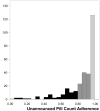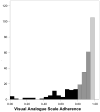A simple single-item rating scale to measure medication adherence: further evidence for convergent validity
- PMID: 19952289
- PMCID: PMC3015098
- DOI: 10.1177/1545109709352884
A simple single-item rating scale to measure medication adherence: further evidence for convergent validity
Abstract
Background: Self-report measures of medication adherence are inexpensive and minimally intrusive. However, the validity of self-reported adherence is compromised by recall errors for missed doses and socially desirable responding.
Method: Examined the convergent validity of 2 self-report adherence measures administered by computerized interview: (a) recall of missed doses and (b) a single-item visual analogue rating scale (VAS). Adherence was also monitored using unannounced phone-based pill counts that served as an objective benchmark.
Results: The VAS obtained adherence estimates that paralleled unannounced pill counts (UPCs). In contrast, self-reported recall (SR-recall) of missed medications consistently overestimated adherence. Correlations with participant characteristics also suggested that the computer-administered VAS was less influenced by response biases than SR-recall of missed medication doses.
Conclusions: A single-item VAS offers an inexpensive and valid method of assessing medication adherence that may be useful in clinical as well as research settings.
Figures
Similar articles
-
Reliability and validity of a single-item rating scale to monitor medication adherence for people living with HIV and lower health literacy.HIV Clin Trials. 2015 Jan-Feb;16(1):1-9. doi: 10.1179/1528433614Z.0000000004. Epub 2015 Jan 9. HIV Clin Trials. 2015. PMID: 25777184 Free PMC article.
-
Monthly unannounced pill counts for monitoring HIV treatment adherence: tests for self-monitoring and reactivity effects.HIV Clin Trials. 2010 Nov-Dec;11(6):325-31. doi: 10.1310/hct1106-325. HIV Clin Trials. 2010. PMID: 21239360 Free PMC article. Clinical Trial.
-
Monitoring medication adherence by unannounced pill counts conducted by telephone: reliability and criterion-related validity.HIV Clin Trials. 2008 Sep-Oct;9(5):298-308. doi: 10.1310/hct0905-298. HIV Clin Trials. 2008. PMID: 18977718 Free PMC article.
-
Visual analogue scale (VAS) measurement of antiretroviral adherence in people living with HIV (PLWH): a meta-analysis.J Behav Med. 2016 Dec;39(6):1043-1055. doi: 10.1007/s10865-016-9770-6. Epub 2016 Aug 1. J Behav Med. 2016. PMID: 27481102 Review.
-
Analysis of Systematic Reviews of Medication Adherence Interventions for Persons with HIV, 1996-2017.AIDS Patient Care STDS. 2019 Dec;33(12):528-537. doi: 10.1089/apc.2019.0125. Epub 2019 Nov 21. AIDS Patient Care STDS. 2019. PMID: 31750731 Free PMC article. Review.
Cited by
-
Antiretroviral medication treatment for all HIV-infected individuals: a protocol using innovative multilevel methodologies to evaluate New York City's universal ART policy among problem substance users.BMC Health Serv Res. 2016 Aug 2;16(a):341. doi: 10.1186/s12913-016-1554-8. BMC Health Serv Res. 2016. PMID: 27485435 Free PMC article.
-
Risk indicators for oral ulcers among people living with HIV during the first wave of the pandemic: a cross sectional study.BMC Oral Health. 2023 Aug 27;23(1):600. doi: 10.1186/s12903-023-03330-2. BMC Oral Health. 2023. PMID: 37635219 Free PMC article.
-
Adherence to Combination Antiretroviral Therapy among Pregnant Women Enrolled in a HIV Prevention Program in Rural North-central Nigeria.Int J MCH AIDS. 2020;9(1):81-92. doi: 10.21106/ijma.327. Epub 2020 Jan 12. Int J MCH AIDS. 2020. PMID: 32123632 Free PMC article.
-
Unannounced telephone-based pill counts: a valid and feasible method for monitoring adherence.AIDS Behav. 2014 Dec;18(12):2265-73. doi: 10.1007/s10461-014-0916-7. AIDS Behav. 2014. PMID: 25331265 Free PMC article.
-
Suitability of Measures of Pharmacy-Based Medication Adherence for Routine Clinical Use Among Patients with Chronic Diseases: A Systematic Review.Patient Prefer Adherence. 2025 Jan 30;19:265-278. doi: 10.2147/PPA.S492461. eCollection 2025. Patient Prefer Adherence. 2025. PMID: 39901904 Free PMC article. Review.
References
-
- Kalichman SC, et al. Pillboxes and antiretroviral adherence: Prevalence of use, perceived benefits, and implications for electronic medication monitoring devices. AIDS Patient Care STDs. 2005;19:49–55. - PubMed
-
- Bangsberg DR, et al. Comparing objective measures of adherence to HIV antiretroviral therapy: Electronic medication monitors and unannounced pill counts. AIDS and Behavior. 2001;5:275–281.
Publication types
MeSH terms
Substances
Grants and funding
LinkOut - more resources
Full Text Sources
Medical
Research Materials



